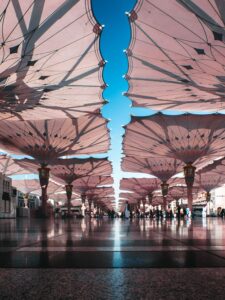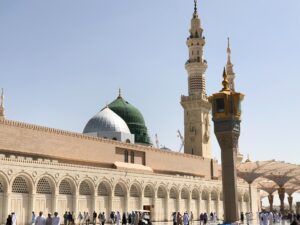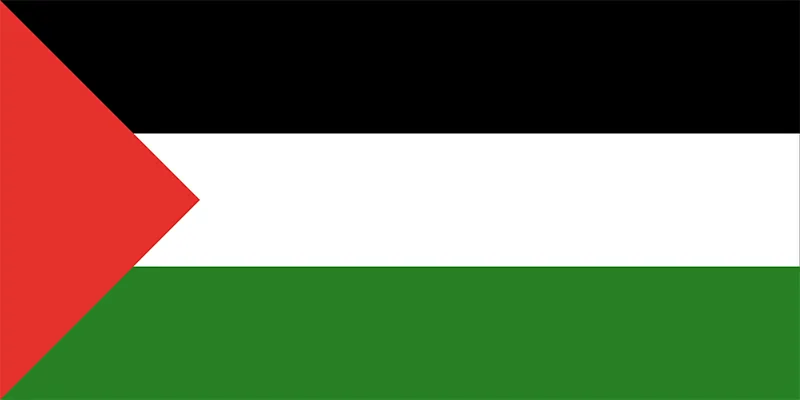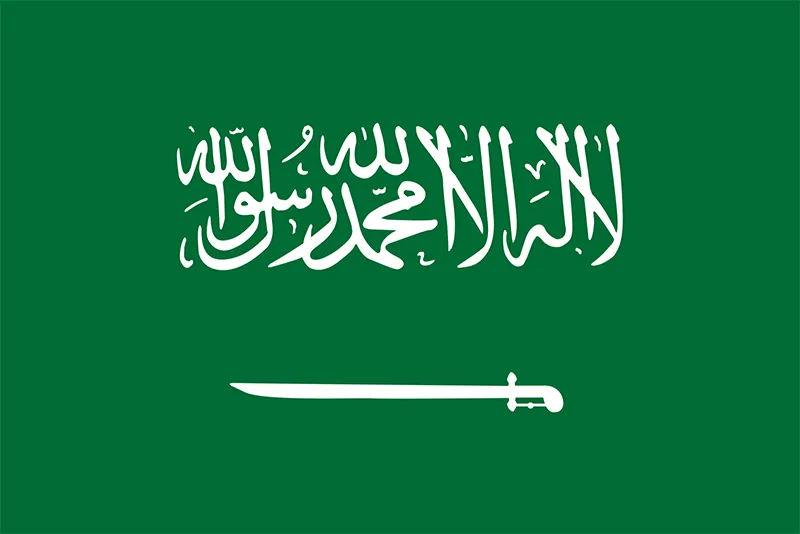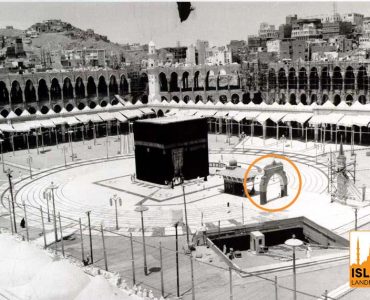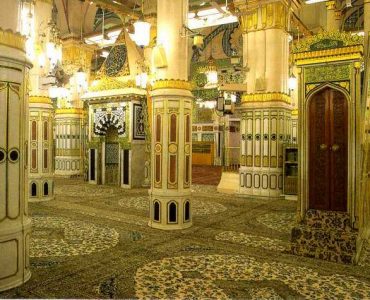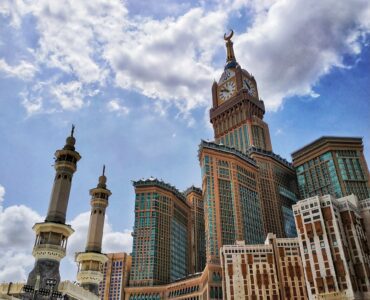Visited by millions of Muslims every year, Masjid al Nabawi is the second largest and second holiest mosque in Islam. Located in the heart of Madinah in Saudi Arabia, Masjid al Nabawi has a special place in the hearts of Muslims all over.
Often referred to as “Heaven on Earth,” the green-domed Mosque is the burial place of Prophet Muhammad (PBUH) and has expanded significantly over the years. In addition to being a place of spirituality, Masjid al Nabawi is also used for political, social, cultural, religious, and administrative functions and activities. Keep reading to learn ten amazing facts about Masjid al Nabawi.
Brief history of Al-Masjid Al Nabawi
After arriving in Madinah, an overjoyed Muslim community welcomed Prophet Muhammad (PBUH). While every family asked the Messenger (PBUH) of Allah SWT to stay with them, Prophet’s she-camel al-Qaswa walked towards the south of Madinah.
When people tried to get hold of her, Prophet Muhammad (PBUH) said, “Let her go her way, for she is under the command of Allah SWT.”
Al-Qaswa kept walking until it stopped and knelt down in a large courtyard owned by two orphans, Suhayl and Sahil (RA). When the two boys learned that Prophet Muhammad (PBUH) wanted to build a mosque on their land, they offered the land as a gift without a second thought.
However, because the boys were orphans, Prophet Muhammad (PBUH) and Abu Bakr (RA) bought the land for 10 dinars. After the purchase, Prophet Muhammad (PBUH) exhumed the graves, cleared the shrubbery, and started constructing Masjid al Nabawi.
Anas bin Malik (RA) narrates, “The location where the Prophet’s Mosque (PBUH) was built belonged to Banu Najjar. In it, there were date-palm trees and graves of the idolaters. The Prophet (PBUH) said to them: ‘Name its price.’ They said: ‘We will never take any money for it.’ The Prophet built (PBUH) it, and they were assisting him, and the Prophet (PBUH) was saying: ‘The real life is the life of the Hereafter, so forgive the Ansar and the Muhajirah.’ Before the mosque was built, the Prophet (PBUH) would perform prayer wherever he was when the time for prayer came.” [Narated in Sunan Ibn Majah]
Why is the Prophet’s Mosque (Masjid Al Nabawi) important?
Masjid al Nabawi is amongst the holiest sites in Islam. The mosque was made by Prophet Muhammad (PBUH) in the wake of the migration from Makkah to Madinah (Hijrah).
Allah SWT in the Holy Quran says, “Verily, the mosque whose foundation was laid from the first day on piety is more worthy that you stand therein (to pray). In it are men who love to clean and purify themselves. And Allah loves those who make themselves clean and pure.” (Holy Quran, Surah Al-Taubah, 108)
Even though the Prophet’s Mosque originally featured a mud brick, open-air architecture with a raised platform for the recitation of the Holy Quran, today, Masjid al Nabawi is covered with a beautiful green dome, white-marbled floors, golden railings, minarets, sliding door courtyards, air conditioning, retractable umbrellas, and comfort stations.
Stating the significance of Masjid al Nabawi, The Messenger (PBUH) of Allah SWT said, “Whoever visits me after my death is like he who had visited me during my life.
When a person stands at my grave reciting blessings on me, I hear it, and whoever calls for blessings on me in any other place, his every need in this world and the hereafter is fulfilled, and on the day of Qiyamah I shall be his witness and intercessor.”
“One prayer in my mosque is better than one thousand prayers in any other mosque except al-Masjid al-Haram.” (Sahih Bukhari: No. 1116)
“Do not prepare yourself for a journey to any mosque [with the intention to earn a special reward of prayers] but the three mosques al-Masjid al-Haram, al-Masjid al-Aqsa, and my mosque.” (Sahih Bukhari: No. 1115)
“Whoever performs forty salah in my Masjid (Masjid al Nabawi), not missing one Salah in the Masjid, for him is granted exemption from the fire of hell, and exemption from the punishment, and he shall remain free of hypocrisy.”
10 Interesting Facts about Masjid Al Nabawi
Being the focal point of Madinah, Masjid al Nabawi is congregated by millions of Muslims annually. In fact, most of Muslims spend their entire life working hard, earning, and saving money to perform Umrah or Hajj and pray inside the Prophet’s Mosque at least once in their lifetime.
Although Masjid al Nabawi is one of the most notable and renowned structures in Islam, there are several things about the sacred site that you don’t know about. In this section, we will be highlighting ten interesting facts about Masjid al Nabawi.
Masjid Al Nabawi is adjacent to the home of Prophet Muhammad (PBUH)
Prophet Muhammad (PBUH), along with his wife, Aisha (RA), lived next to Masjid al Nabawi. The Sacred Chamber inside the mosque is said to be the house of Prophet Muhammad (PBUH) and is located in the southern section of the Masjid.
Who was the first imam of Masjid Nabawi?
The first imam of Masjid al Nabawi was our beloved Prophet Muhammad (PBUH). During his life, Allah SWT’s Messenger (PBUH) led several prayers and delivered many sermons in Masjid Nabawi.
How old is Masjid Al Nabawi?
According to Islamic history, it took Prophet Muhammad (PBUH) and his companions eight months to build Masjid al Nabawi 1,401 years ago. The construction of Masjid al Nabawi started in September 622 AD (Rabi-ul-awaal), and the mosque was completed in April 632 AD (Shawwal).
Why is Masjid Al Nabawi green?
Also known as Gunbad-e-Khizra, the magnificent green-coloured dome is the most distinctive feature of Masjid al Nabawi. According to Islamic scriptures, Masjid al Nabawi’s dome wasn’t always green. In fact, after its construction in 678 AH, the dome was renovated several times throughout history.
The unpainted wooden cupola was first painted white, blue, or purple, then green in the reign of Ottoman Sultan Abd al-Hameed in 1253 AH. The reason behind the repaint was to hide the cracks in the dome’s structure. Soon after, the people started referring to Masjid al Nabawi as the Green Dome.
Furthermore, green colour has a special place in Islam as it was supposedly the favourite colour of Prophet Muhammad (PBUH). Several Islamic scriptures have said that the Messenger (PBUH) of Allah SWT often wore a green turban and green cloak.
A passage in the Holy Quran describes Jannah (Heaven) as a place where people “will wear green garments of fine silk.” According to a Hadith, Prophet Muhammad (PBUH) passed away wearing a green square-shaped Hibra Burd. Thus, from the dome to the carpet, many things in the Prophet Mosque are green.
Masjid Al Nabawi is larger than the Old City of Yathrib (Madinah)
Covering 82,000 square metres of ground and 12.55 metres in height, the current structure of Masjid al Nabawi is larger than the old city of Madinah. Since its creation, Masjid al Nabawi has expanded by 100 times.
Initially, Jannat ul Baqi was located on the outskirts of Madinah. However, today it is within the premises of the Prophet’s Mosque. According to reports, more than 3.2 million people can pray inside Masjid al Nabawi at once, marking it as the second-largest mosque in the world.
Images of Masjid Al Nabawi
History of the silver dome Masjid Al Nabawi
If you have ever had a chance to visit the Mosque of Prophet Muhammad (PBUH) or look at some pictures, you must have noticed a shiny silver-coloured dome adjacent to the famous green dome. But did you know that for over 600 years, there was no dome over Masjid al Nabawi? Mamluk Sultan used wood to make the dome of the Prophet’s Mosque in the 16th century.
In 1916, under the reign of Saudi King Abdulaziz Al Saud, Masjid al Nabawi went under extensive upgrades, and the dome was replaced with a silver one. It was rebuilt during King Fahad bin Abdul Aziz’s reign and is currently made of 24-karat gold-plated stainless steel. The silver dome is 26 metres in diameter and weighs 160 tons.
The Saudi municipality 2007 tried to paint the green dome in silver colour in order to match it with the other domes. However, the people of Madinah stood up against the cause by launching an unprecedented protest. This left the municipality with no choice but to repaint the dome in green colour.
There are six mehrabs in Masjid Al Nabawi
While you might see only one Mihrab in the Mosque of Prophet Muhammad (PBUH), there are actually three. The Mirbah that is used by the Imam is the same one that was used by the Messenger (PBUH) of Allah SWT to lead prayers. This Mihrab is also called “Mihrab Nabawi” and “Mihrab Hanafi.”
Other Mehrabs in Masjid al Nabawi include Mihrab Tahajjud, Mihrab Bait ul-Muqadis, Mihrab Uthmani, Mihrab Suleimani, and Mihrab Fatimah.
Who gave the first Azan?
The first muezzin of Masjid al Nabawi was Bilal ibn Rabah (RA). He was the son of an Ethiopian mother and an Arab father. Bilal ibn Rabah (RA) was born in Makkah in the 6th century and was a slave to a rich man. He was one of the earliest converts to Islam and was freed by Prophet Muhammad (PBUH) and Abu Bakr (RA).
After migration to Madinah, the number of Muslims grew rapidly, and it became difficult to call everyone for prayer five times a day. This started conversations on how to call Muslims for prayer. Amidst all discussion, Abdullah Bin Zaid (RA) had a dream in which he saw a man wearing two green garments in his dream, carrying a bell.
Abdullah Bin Zaid (RA) said, “O slave of Allah, will you sell the bell?” He said, “What will you do with it?” Abdullah Bin Zaid (RA) replied, “I will call (the people) to prayer.” He said, “Shall I not tell you of something better than that?” Abdullah Bin Zaid RA asked, “What is it?” he said, reading out the following words:
“God is most great! God is most great!
I testify that there is no god but God.
I testify that Muhammad is the apostle of God.
Come to prayer! Come to prayer!
Come to salvation! Come to salvation!
God is most great! God is most great!
There is no god but God.”
The next day Abdullah Bin Zaid (RA) went to the Messenger (PBUH) of Allah SWT and told him about the dream. Prophet Muhammad (PBUH) said, “Go out with Bilal (RA) to the mosque and teach it to him, for he has a louder voice than you.” Abdullah Bin Zaid (RA) went out with Bilal (RA) to Masjid al Nabawi and taught him the words of Azaan, which Bilal (RA) called out.
Hearing the words of the Azaan, Umar (RA) came to Prophet Muhammad (PBUH) and said, “O Messenger of Allah! By Allah, I saw the same (dream) like him.” These verses were officiated as the Azaan. Even today, the same words are used to call Muslims for the five prayer times: Fajr, Zuhr, Asr, Maghrib, and Isha.
There is an empty grave for Isa (AS) in Masjid Al Nabawi
Rawdah in Masjid al Nabawi is a sacred chamber that holds the graves of Prophet Muhammad (PBUH), Abu Bakr (RA), and Umar (RA). However, very few people know there is an empty fourth grave in Rawdah Mubarak reserved for Isa (AS).
It is believed that Prophet Isa (AS) will return and will be buried in the grave beside Prophet Muhammad (PBUH).
Masjid Al Nabawi was the first place to have electric lights in the Arabian Peninsula
One of the most interesting facts about Masjid al Nabawi is that under the reign of Ottoman Sultan Abdul Hamid II in 1909, the Prophet’s Mosque was the first place to receive electric lights in the Arabian Peninsula.
Today, the interior of Masjid al Nabawi dazzles with more than 100,000 light bulbs and 2000 chandeliers. The Prophet’s Mosque is also well-equipped and features 1000 speakers, allowing the Azaan to be heard for up to 6.2 miles (10 kilometres).
Holiest Mosques in Islam
The Messenger (PBUH) of Allah SWT said, “Do not prepare yourself for a journey to any mosque [with the intention to earn a special reward of prayers] but the three mosques al-Masjid al-Haram, al-Masjid al-Aqsa, and my mosque.” (Sahih Bukhari: No. 1115)
From the Great Mosque of Makkah to the cave of Hira and Jabal an-Nur, every holy site has great importance in the history of Islam. In light of the above-mentioned hadith, we will be reviewing the three most significant and holy sites in Islam:
Masjid al-Haram
Surrounding the Holy Kaaba, Masjid al-Haram is located in Makkah, Saudi Arabia. It is the largest mosque in the world and the site for pilgrimage (Umrah and Hajj). According to narrations, Masjid al-Haram was created by Prophet Ibrahim (AS) and his son Prophet Ismail (AS), under the orders of Allah SWT.
Important structures of Masjid al-Haram include the Holy Kaaba, Hajar-e-Aswad, the Station of Ibrahim, Safa, and Marwa, and the well of Zamzam.
Masjid Al-Aqsa
Masjid al Aqsa is located in the Old City of Jerusalem. Masjid al Aqsa is the second oldest mosque in the world and is sacred for the believers of Islam, Judaism, and Christianity. Masjid al Aqsa features a Noble Sanctuary named Al-Haram Al-Sharif and the Dome of Rock.
Masjid Al Nabawi
Masjid al Nabawi is situated in the city of Madinah. It was established by Prophet Muhammad (PBUH) and is the second-largest mosque in the world. Masjid al Nabawi is the holiest site in Islam after Masjid al-Haram and is the burial place of the Messenger (PBUH) of Allah SWT.
Summary – Facts about Masjid Al Nabawi
Originally constructed by Prophet Muhammad (PBUH) in the city of Madinah, Saudi Arabia, Masjid al Nabawi is the second largest mosque in the world after Masjid al-Haram in Makkah. Masjid al Nabawi is believed to be built on the site adjacent to the house of the Messenger (PBUH) of Allah SWT. The foundation of the Prophet’s (PBUH) Mosque was laid in September 622 AD, and it took eight months to complete the open-air building.
Over the last 1,401 years, Masjid al Nabawi has been reconstructed, renovated, and expanded by several Islamic rulers. The mosque of Prophet Muhammad (PBUH) has served as a religious school, court, and community centre. Masjid al Nabawi isn’t only a mosque but is also the final resting place of Prophet Muhammad (PBUH) and the first two caliphs of Islam, Abu Bakr (RA) and Umar (RA).


